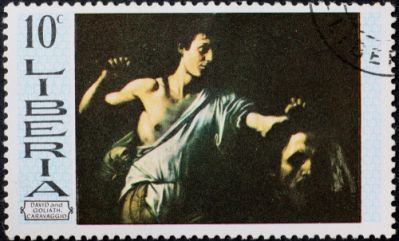 David and Goliath is one of the most common tropes in literature, film, television, and comics. You’re probably familiar with the biblical version. Goliath, the champion of the Philistines, challenges the Israelites to a one-on-one single combat. David, a shepherd who is only delivering food to his brothers, volunteers to take on Goliath with only a slingshot. Of course, David wins and cuts off Goliath’s head, and the Philistines flee.
David and Goliath is one of the most common tropes in literature, film, television, and comics. You’re probably familiar with the biblical version. Goliath, the champion of the Philistines, challenges the Israelites to a one-on-one single combat. David, a shepherd who is only delivering food to his brothers, volunteers to take on Goliath with only a slingshot. Of course, David wins and cuts off Goliath’s head, and the Philistines flee.
This story is found in the Bible in 1 Samuel 17. It’s implied that David only killed Goliath through divine intervention, but he became a legend in the country. He was the underdog, not even wearing armor to face his adversary. King Saul, the king of Israel, offered him armor but David refused, stating that he was unaccustomed to the heavy apparel and that it was much too big for him. It’s said that Saul was taller than any of the people of Israel. However, it was the small shepherd who dared to take on Goliath.
Film and Television
The theme for this season of “Survivor” is David versus Goliath. The David tribe consists of underdogs like a truck driver, public defender, and writer, going up against a Goliath tribe consisting of overachievers, including a CEO, a SWAT officer, and a financial consultant. At the merge, the Goliath team had the majority by one, but the season isn’t over yet- It will be interesting to see who the winner is. Sometimes, the David versus Goliath theme is very obvious. But other times, the trope is hidden well. Here are some movies that you may not realize were using this trope as part of their storyline.
Indiana Jones is usually the David in his movies. His opponents are not just individuals, but huge entities, such as Nazi Germany in “Raiders of the Lost Ark,” or an evil cult in “Indiana Jones and the Temple of Doom.” Still, using just a bullwhip and his smarts, Professor Jones is able to foil the plots of the villains, save the day, and get the girl.
Practically every sports movie relies on the David versus Goliath theme. “Miracle” might be one of the best, focusing on the 1980 Winter Olympics. The Soviet Union team had dominated the world hockey scene for generations, but the US men’s hockey team managed to take the Gold in 1980 in the upset of the century. The movie “Hoosiers” follows a similar format. The small, rural team seemingly stands no chance against the huge, urban school. The prayer before the championship game even included a David v. Goliath reference.
The Star Wars franchise also uses the trope. Luke Skywalker is just a farm boy from a remote desert planet. The villainous Darth Vader is a pilot and warrior- and isn’t afraid to use the force to improve his odds. And don’t forget the Death Star versus the Rebel fighters. It’s classic David versus Goliath.
Wolverine, from the “X-Men” franchise, is a smaller super-hero than most of the villains he takes on. His tools are largely defensive and include an adamantium skeleton that makes him hard to damage while his regeneration powers heal him quickly. Offensively, he mainly has experience in combat and blades in his hands. His enemies are much more powerful and unafraid to fight dirty.
Paul Newman stars in “The Verdict,” a 1982 courtroom drama that was nominated for five Academy Awards. Newman’s character is a washed-up lawyer taking on a high-powered legal team sponsored by the Catholic Church. He rejects the settlement that the Archdiocese offers, which displeases everyone, including his clients. The trial is his last chance to save himself. It’s a fight against a Goliath. Can you guess who wins?
Why Do Tropes Matter?
Knowing the story of David and Goliath can help you understand what the author is trying to say through a story. Tropes are powerful tools. They’re variations on a theme. The David v. Goliath trope may not be original, but it does lend itself to interesting underdog characters and exciting outcomes!
Add Your Comment